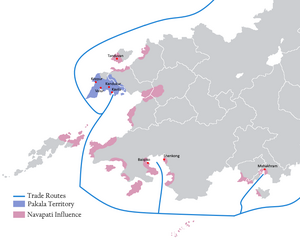Navapati
The Navapati (Tamisari: నావపతి nāvapati) were Purvan pirates, privateers, and merchants who operated in Western Satria, where they enjoyed the patronage of the Pakala dynasty. They largely worked as merchants, plying trade routes as far north as the Aurean Straits, and east as the Maccan Sea, with some being recorded as far as Caldia in 1704. Despite this they are well-known for their role in raiding the coasts of southern and south-east Coius, preying upon coastal towns and ships alike.
The primary aim of their raids was to capture wealth and goods, of which a quarter was given to Pakalan officials. In return they received safe harbour, and in some cases letters of marque, legalising their piracy, although in most cases authorities turned a blind eye to their activities and allowed them to escape. The fragmented nature of the Pakalan dynasty meant that they were always able to reestablish themselves in a new safe harbour. Other than this, they also notoriously traded in human cargo, enslaving many of those they captured. The majority of these were ransomed back, but others were forced into a new life in modern-day Padaratha, or sold on. When slavery was slowly outlawed by Euclean nations in the 19th century, the Navapati played a role in facilitating indentured servitude.
At their height in the later 17th and early 18th century, they were considered a great threat, particularly in the Bay of Bashurat and Honghai Sea. They spurred the initial abandonment of some stretches of coast in Senria and Xiaodong, followed by a surge in coastal defences. The Toki dynasty and daimyou-controlled Senria also began to outfit naval forces against them, to mild success, as well as pay off the Navapati, in the case of the former, and employ pirates of their own, the Kurutta, in the case of the latter.
By the late 18th century their influence had waned, thanks to growing Euclean influence in Coius which diminished their ability to both trade and plunder. They had a resurgence during Estmere's conquest of Padaratha, where the Zamorins acted as the naval commanders and managed to upset the Estmerish companies' plans for a near half-century. In 1841 the last Zamorin surrendered to Estmere, though their institution did not initially end. They were allowed to continue legal trade, under the Estmerish flag, while others were drafted into the Estmerish navy. By the end of the 19th century though, they had largely been integrated and no longer organised themselves in the traditional panja.
History
Organisation
Panja
పంజా Pan̄jā - Claw
